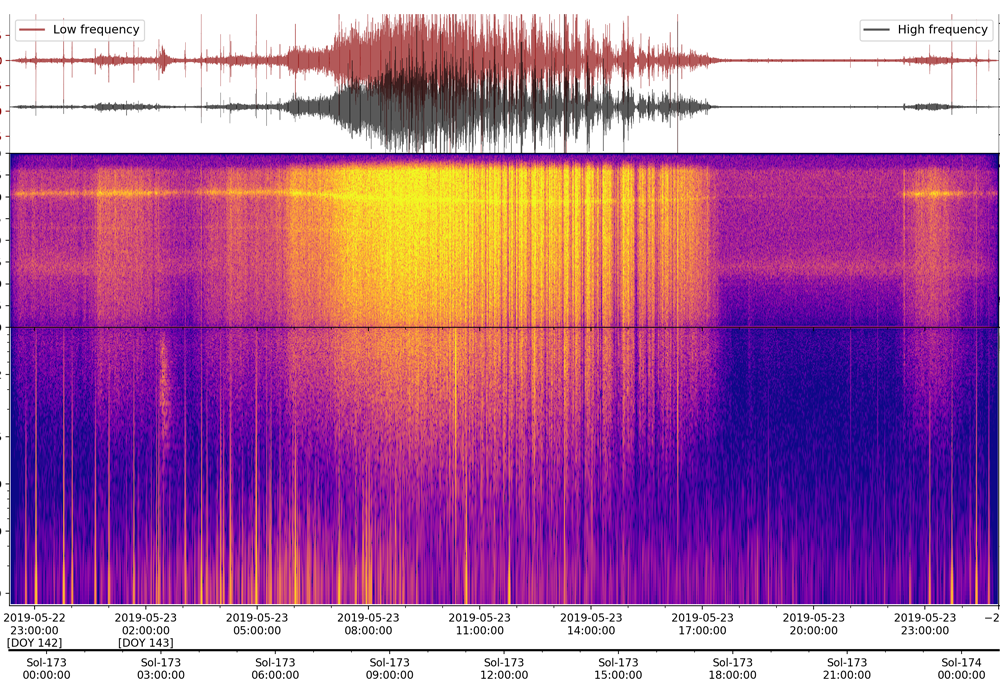 Fifty years after Apollo 11 astronauts deployed the first seismometer on the surface of the Moon, NASA InSight’s seismic experiment transmits data giving researchers the opportunity to compare marsquakes to moon and earthquakes.
Fifty years after Apollo 11 astronauts deployed the first seismometer on the surface of the Moon, NASA InSight’s seismic experiment transmits data giving researchers the opportunity to compare marsquakes to moon and earthquakes.
Seismologists operating the Marsquake Service at ETH Zurich literally rocked and rolled as they experienced, for the first time, two “marsquakes” in the university’s quake simulator. Researchers uploaded actual data from marsquakes detected on Martian solar day or Sol 128 and 173.The marsquakes were detected by the SEIS seismometer, whose highly sensitive electronics were delivered by the Aerospace Electronics and Instruments laboratory at ETH.
Two Types of Marsquakes
SEIS contains arguably the most sensitive seismometer ever operated, capable of detecting even the faintest seismic signals on Mars. Researchers had to amplify the marsquake signals by a factor of 10 million in order to make the quiet and distant tremors perceptible in ETH Zurich’s quake simulator and to compare them with a similarly amplified moon and earthquake.
“We are currently observing two families of quakes on Mars,” says Dr. Simon Stähler. “The first quake was a high frequency event more similar to a moonquake than we expected. The second quake was a much lower frequency, and we think this may be due to the distance. The lower frequency quake likely occurred further away from the seismometer. Compared to the duration of earthquakes, both types of the marsquakes last longer.”
Earth, Moon, and Marsquakes
While seismic waves that travel through the Earth typically persist between 10s of seconds to a few minutes, moonquakes can last up to an hour or more. The extent of the seismic signal is due to distance and to differences in geological structures. If one compares the surfaces of the Earth and the Moon, it might be surprising to learn that the Earth’s crust is more homogeneous than that of the Moon. Billions of years of meteorite impacts fractured the lunar crust and there is no process, on the Moon, that “bakes” the rocks together. On the Earth, volcanism, interior heating, and plate tectonics, as well as erosion and deposition from water and wind meld broken rocks together creating a relatively unbroken and layered crust quickly erasing the traces of meteorite impacts.
“The heterogeneous lunar crust scatters seismic waves, similar to the reverberating echoes one might experience when calling out in rugged mountain terrain,” says Dr. John Clinton, who leads operations at the Marsquake Service at ETH Zurich. The Earth’s crust and mantle, by comparison, are transparent to seismic waves – much like a wide-open space is to sound waves. While seismic sensors on Earth “hear” earthquake signals cleanly, on the Moon seismic sensors detect a plethora of echoes that distort the signal making it very hard to even identify where the signals begin. While seismic research is still in its infancy on Mars, marsquakes appear to be somewhere in between moon and earthquakes. Researchers recognize the first seismic signals of the marsquake, but the signals that follow include more echoes than scientists expected. The duration of a marsquake signal can be approximately 10 to 20 minutes. Scientists do not yet know whether the fractured part of the Martian crust is just few kilometers deep, as it is on the moon, or if it is shallower.
Marsquake Service Ops
Domenico Giardini, Professor of Geophysics and Seismology, leads the Swiss participation in the InSight mission. He established the Marsquake Service (MQS) center at ETH Zurich. Roughly, twice each day, an international team of ten seismologists analyses seismic data from Mars with the aim of detecting and characterizing marsquakes.
Since there is only one seismometer on Mars, Giardini and his team combine methods taken from the early days of seismology, when there were only a few seismometers on Earth, with modern analytic methods for locating seismic events. Ultimately, researchers look to the seismic data to answer questions, not only about the interior geological structure of Mars, but also how early planets in the inner solar system formed more than four billion years ago.
The Marsquake Service is a collaborative ground service operation led by ETH Zurich and includes seismologists from the Institute of Geophysics and the Swiss Seismological Service at ETH Zurich, IPG Paris, ISAE Toulouse, University of Bristol, Imperial College London, MPS Gottingen, and JPL Pasadena.